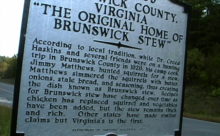Southern Stews, Supplemental Information
Written by Woodward to supplement his 2015 interview with Saddler Taylor and Tom Davenport.
My folklife documentary filmmaking accelerated when I moved back to my home state of SC in 2000. And one of the catalysts who made this possible was my old friend and co-producer of my seminal Southern folklife documentary, ITS GRITS back in 1980, Jay Williams. Jay served as Chief Curator for McKissick Museum at U.S.C. and Coordinator of its Folklife Resource Center. We immediately connected upon my arrival in Greenville where I worked as Coordinator and Designer of Distance Learning for the new SC Governors School for the Arts and Humanities under construction. I had just completed and premiered my documentary in Richmond, VA on Brunswick stew, telling the story behind the Brunswick stew tradition in Brunswick County Virginia - the self-proclaimed "Home of Brunswick Stew". Jay was excited about the idea of creating an exhibition at McKissick based on the film. The title of the exhibition would be "Southern Stews" and would use the Brunswick Stew documentary as the centerpiece of the exhibition as well as the rich material I had gathered while conducting field research on the project that turned up a wide range of communal stew traditions being cooked in huge black iron pots by stewmasters and stew crews spread across the South. The exhibit would be a combination of clips from the abundance of footage I had shot documenting these other stews and objects from the material culture of these stew traditions.
Jay proposed that I shoot a documentary that utilized a lot of the stew-making footage I had gathered while researching and shooting the Virginia Brunswick stew documentary and supplement it with fresh footage shot for this new documentary. We wrote grants to the Southern Humanities Media Fund administered by the Virginia Council for the Humanities as well as the SC humanities Council and were able to produce the documentary titled "Southern Stews". The documentary would utilize the Southern food writer, John Egerton as commentator and would feature Virginia and Georgia Brunswick stew, Carolina hash, South Carolina Chicken Bog and Frogmore Stew, Sheep stew from Dundas, Virginia, and Kentucky's folk heritage stew called Burgoo. It would provide the opportunity to document the strong similarities in these different stew cultures that are manifestations of the shared agrarian roots that fostered them, as well as provide the opportunity to tell the colorful story of the ongoing Brunswick stew wars between Georgia and Virginia, and to introduce the history behind South Carolina's native stew, Carolina hash, and the reason this stew historically preceded Brunswick stew and became the state's stew of choice to the exclusion of Brunswick stew, which was the stew of choice in the neighboring states of Virginia, North Carolina and Georgia.
During the shooting of "Southern Stews" we gathered an abundance of footage on other stew traditions: the Kentucky Burgoo tradition that would later provide the basis for an entire documentary on Burgoo; the Carolina hash tradition, that would lead to an entire documentary on Carolina Hash; South Carolina Chicken Bog, that would later provide the basis for an entire production on Chicken Bog. In addition, as part of making the Southern Stews documentary I also gathered additional footage on the cooking of sheep stew in Dundas, VA to supplement footage gathered earlier during the course of producing the Virginia Brunswick Stew documentary, facilitating production of a subsequent documentary on The Sheep Stew of Dundas. The footage shot on the Georgia Brunswick stew tradition during the shooting of Southern Stews was later combined with earlier footage gathered during the making of the Virginia Brunswick Stew documentary, forming the basis for the later documentary on Georgia Brunswick Stew. So there were many works that were derivatives from the "Southern Stews" documentary project.
This followed a pattern of conscious overshooting as I worked on different Southern culture documentaries, keeping in mind the possibilities for building other documentaries from subject matter that I might gather that may be tangential to the film I was working on. Because in my mind, all Southern folklife is connected to a broad tapestry of Southern culture and traditional arts that overlap and interconnect, but each having its own individual story. So, if I ran into stories about Georgia Brunswick stew and its folk heritage roots while conducting field research on a Southern Stews documentary, I would shoot and store that footage, knowing that, one day, I might have the opportunity to produce a film about the folk heritage roots of Georgia Brunswick stew.
This method of "overshooting" was not possible in the days when 16mm film was the predominant medium for shooting documentaries, because of the sheer cost of film stock and the lab fees and editing costs and finishing costs of film. But with the move over to digital video as the medium of choice during the 1990's, the cost of video cassettes for a production was substantially less. This facilitated the method of "overshooting" on my projects. And in this way, "Southern Stews" gave life to future films on Kentucky Burgoo, SC Chicken Bog, Carolina Hash, and Georgia Brunswick Stew. In like manner subsequent films like "Barbecue and Homecooking" led to other SC folklife documentaries like "The Morris Chronicle", "Ol' Timey Horse Farmers Gathering", "Ehrhardt Five and Dime", and "Cooperative Grocery". All are the results of my method of "overshooting" on the run while working on a particular project. Once I'm finished on the main project I will have gathered enough footage on ancillary subjects that enable me to later go back and focus on them.
